Snow Peaks and Magnificent Mornings at Dochula, Bhutan
If I have to think of brilliant view of a long line of Snow Peaks in the Himalayas, Dochula Pass in Bhutan quickly comes to mind.
Also see: my upcoming photography tour to Bhutan
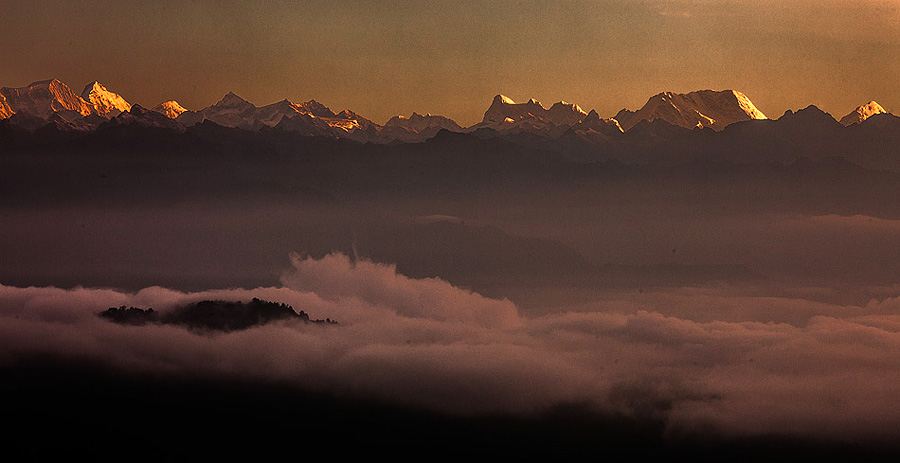
Sunrise from Dochula Pass, Bhutan
At ten thousand feet, DochuLa is not really high by Himalayan standards. But it is a good enough altitude to get clean air and a clear view of high mountains that are as far away as a hundred kilometers. On the horizon towards north-east from DochuLa is a long line of white summits on exhibit. The peaks include the who’s who of Bhutan’s mountain landscapes, Gangkar Puensum topping the altitude graph among them all. At 7,570 meters, Gangkar Puensum is also the world’s highest unclimbed peak today, primarily because sanctity of the peak makes it off-limits to mountaineers.
It was a beautiful May afternoon when I was on my way to witness this vista from Dochula. Our vehicle made the slow climb to the pass from Thimphu on a balmy summer day, when the weather was remarkably perfect as it usually tends be during these months in Bhutan. There was a mild chill in the air–the kind of temperatures where you are happy with a cotton shirt but start longing for sun when kissed by a breeze.
The road sloped up gradually, quickly putting habitation behind and letting the tall high-altitude vegetation takeover the landscape. Sometime, after an hour’s drive later when the GPS indicated ten thousand feet approaching, we were suddenly at a clearing facing an array of chortens (stupa) to the right and wide open landscape to the left. I craned my neck hoping to see the lofty snow peaks decorating the northern sky.
However, on that summer afternoon, the snowy mountains decided to hide behind white clouds.
Clouds must be a curse that the Himalayas suffer from. Or perhaps they desire to reveal themselves only to the most determined. As the sun moves higher in the sky and the day warms up in these places, nearly every high peak gets draped in cloud-cover and refuses to show up to those who arrives on a pleasant afternoon. But brave the bitter cold to be there before sunrise and they show up in their best, glowing in orange rays of the morning sun.
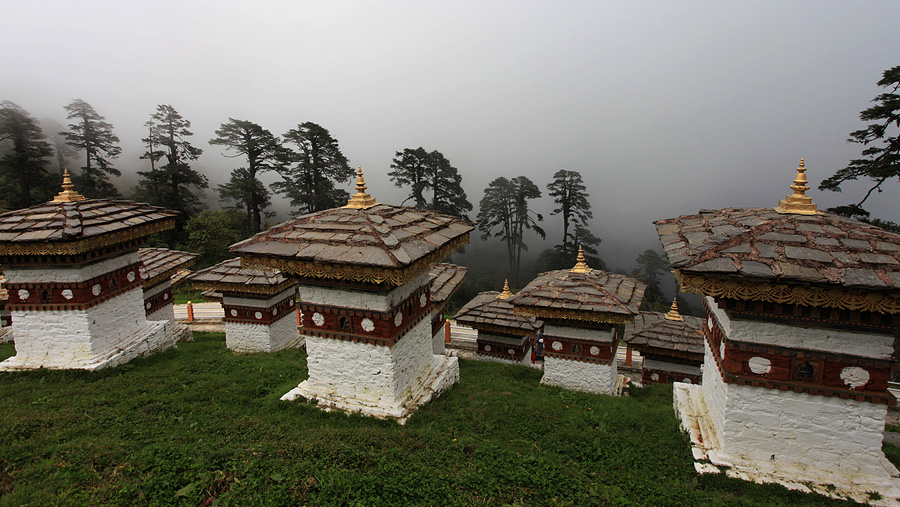
Druk Wangyal Chortens or ‘the 108 chortens’ at Dochula Pass, Bhutan
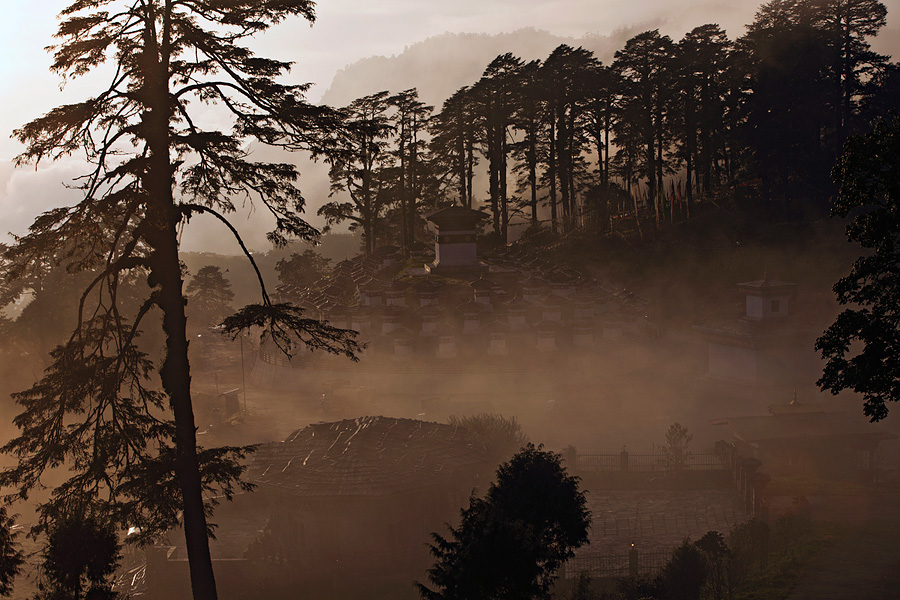
We did not see the mountains that afternoon, but we did not go disappointed either. Views or not, DochuLa is a charming place by itself. At the heart of the large open area that is the mountain pass is a collective of 108 chortens, built after the Royal Bhutan Army evacuated the ULFA militants holed up in the southern jungles. And just above the pass, summer flowers carpeted the forest floor. A splash of colours from a thicket of prayer flags decorated the trees above.
We moved on, distinctly aware of missing the views and at the same time knowing fully that we will be back here again to catch the sunrise. Two days later, we started at an unearthly hour–3am–to make the long journey back to the top of the pass. When we arrived at 5.45am, there was no semblance to the pleasant weather we experienced during the previous visit. It was close to freezing temperatures and the wind made things worse. As if that’s not bad enough, we were thirty minutes early and had to make the long wait in the cold for the first rays of the sun.
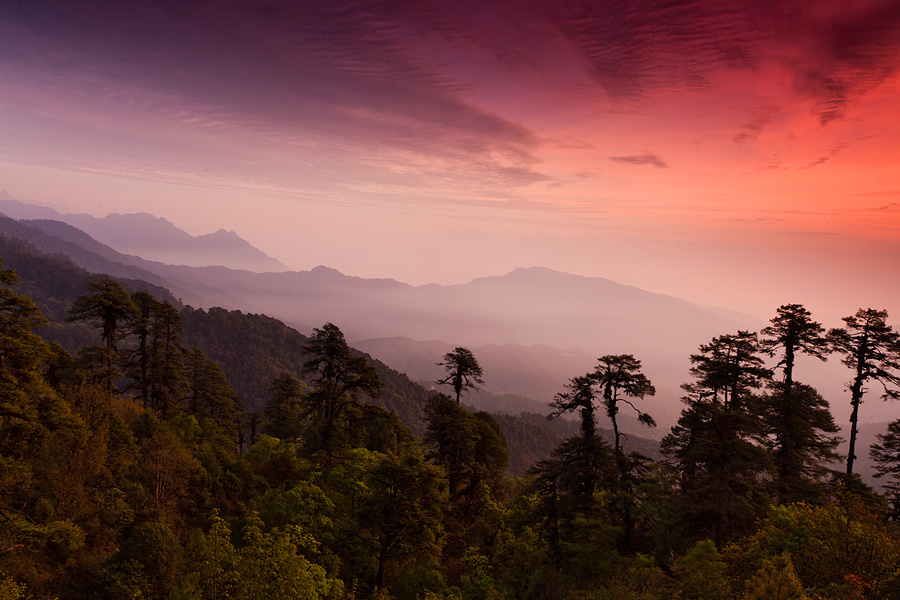
Sunrise from DochuLa Pass, Bhutan
When the sun appeared over the mountains to the east, he painted the sky in various hues or red and revealed the beauty of the valley directly below us. The morning winds inspired by the warmth of sun rays pushed the fog around to decorate the tree tops. The mountains–the tall peaks that we were eager to see–played hide and seek as the clouds played a high-activity game in the skies. When we did glimpse the tall peaks that glowed in the morning glory, our eyes and hearts glowed along with them. In a matter of minutes, the skyline changed from a dark-blue to glowing red to a foggy daylight. Just ahead of us, tall coniferous trees swayed back and forth approving this spectacle.
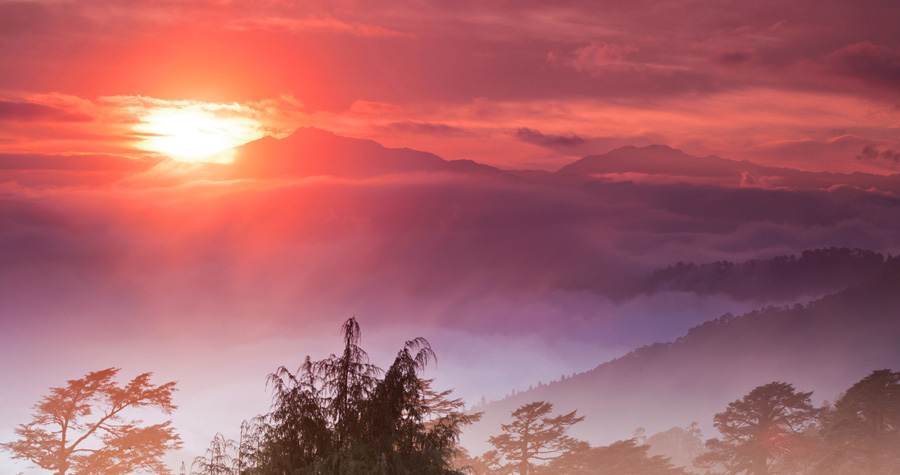
Sunrise from Dochula Pass, Bhutan.
It was a magnificent morning, but I hadn’t had enough of it. Later in September, when they skies open up again after the monsoon months, I was back in DochuLa for another look at the vistas. A similar pattern followed, and the clouds refused us clear views on our first visit during the day. However, they were unusually co-operative during morning two days later and revealed the best of what the mountains had to offer. Another visit followed a year later on a cold October when the winter was just trying to make its presence felt. This time, the day-time views were clear too, but unmatched to the morning glory I had witnessed in the last two visits. As I am writing this, my tickets for the next visit is already in my hands and I am counting days for another summer morning visit to DochuLa.